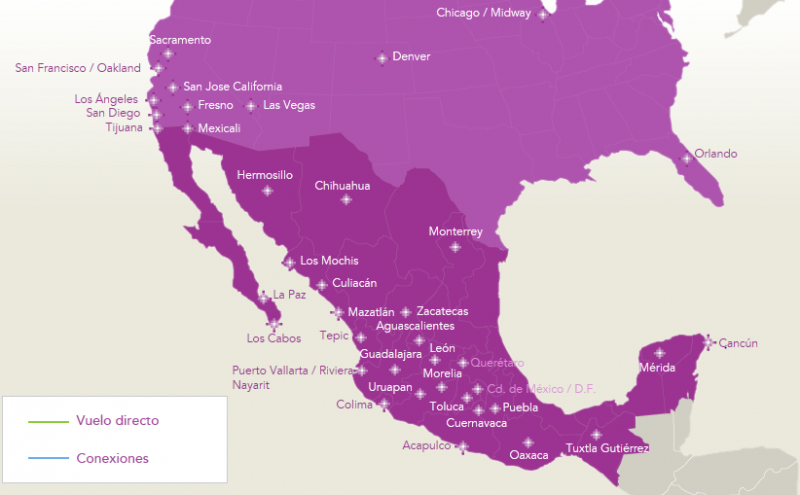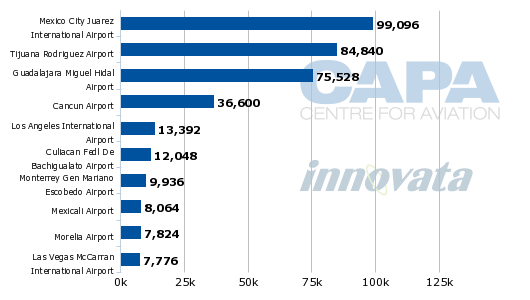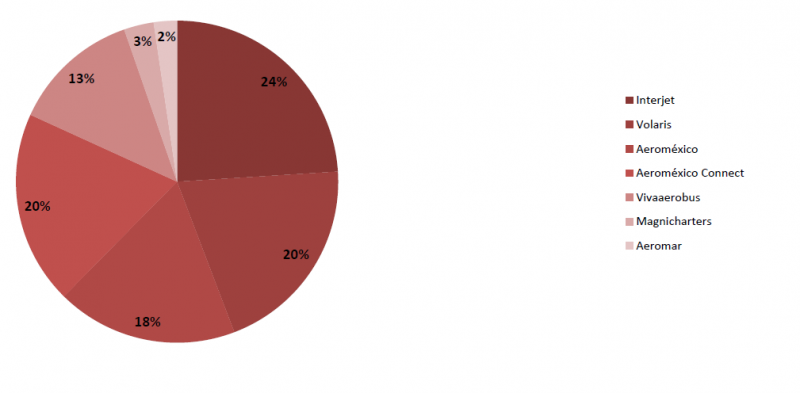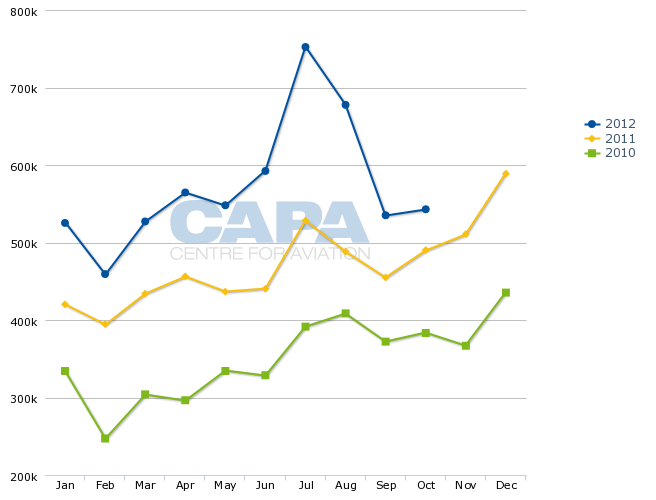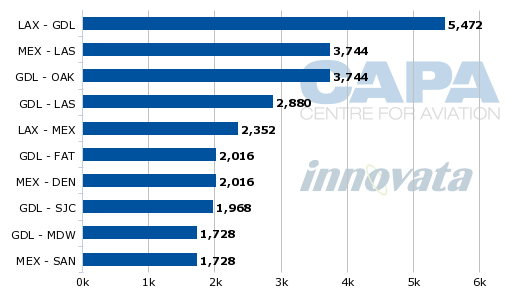Mexico’s LCC Volaris plans more rapid domestic expansion in 2013
Mexico's Volaris is planning another year of rapid expansion as the low-cost carrier sees further opportunities in the Mexican domestic market. The airline also expects to further expand during 2013 in the US, where it now has a network of 10 destinations, but for the second consecutive year faster capacity growth will be pursued domestically.
Volaris, which serves 27 destinations in Mexico, is now the third largest carrier in Mexico's domestic market on a seat capacity basis but the largest on an ASK basis. Volaris expanded its fleet by seven aircraft in 2012, ending the year with 41 A320 family aircraft.
The airline expects to end 2013 with at least 44 aircraft but could end up with up to 48 aircraft if it decides to postpone the phase out of A319s.
- Volaris plans to expand rapidly in the Mexican domestic market in 2013, with a focus on the leisure market.
- The airline expects to grow ASKs by 20% in 2013, with most of the expansion allocated to the domestic market.
- Volaris is the third largest carrier in Mexico's domestic market on a seat capacity basis, but the largest on an ASK basis.
- The carrier plans to end 2013 with at least 44 aircraft, potentially reaching 48 aircraft if it postpones the phase-out of A319s.
- Volaris has a strong presence in western Mexico and is the largest domestic operator based on RPKs or ASKs.
- The carrier is cautious about US growth and is focusing primarily on smaller niche markets, with a focus on ethnic traffic and Mexico outbound leisure traffic.
Volaris says its ASKs grew by 17% in 2012 as 18 new routes were launched - 12 domestic and six to the US - which gave it more new routes last year than any other Mexican carrier. Six destinations were added to its network in 2012, including three in Mexico and three in the US. The carrier does not yet serve any destination outside Mexico and the US.
Volaris plans 20% capacity growth in 2013
Volaris CEO Enrique Beltranena told CAPA at the ALTA Airline Leaders Forum in Nov-2012 that the carrier expects to grow ASKs by a further 20% in 2013 with most of the expansion allocated to the domestic market. Volaris also focused more on domestic expansion in 2012, with the carrier adding about 1.1 million domestic passengers compared to 2011 while adding less than 300,000 international passengers.
According to Mexican DGAC data through the first 11 months of 2012, the carrier's domestic traffic grew by 25% to 5.2 million passengers. Volaris' impressive domestic growth in 2012 outpaced the rest of the Mexican industry, which overall recorded an 11% increase in domestic traffic through the first 11 months of 2011 to 25.6 million passengers.
Volaris' US traffic also grew by 24% through the first 11 months of 2012 to 1.1 million passengers. But this compares to 81% traffic growth in its US operation in 2011, when Volaris added almost 500,000 passengers on a much lower base.
Volaris has particularly seen a slowdown on international growth in recent months, with its US traffic growing year-over-year by only 6% in Nov-2012, 1% in Oct-2012 and 6% in Sep-2012, according to Mexican DGAC data. Volaris currently allocates about 29% of its ASKs and 20% of its seats to the transborder market, according to Innovata data.
The carrier has already unveiled plans to launch two new domestic routes in 1Q2013, Mexico City to Merida and Tuxtla Gutierrez - both of which will be new destinations and result in the carrier's network growing to 29 domestic destinations. With the two new routes Volaris will have a total of 74 routes - 51 domestic and 23 international.
Volaris network map: as of Feb-2013
Mexico City-Merida service will launch on 01-Feb-2013 with five weekly frequencies and Mexico City-Tuxtla Gutierrez service will launch on 15-Feb-2013 with four weekly frequencies. Entering these markets is a key development for Volaris as both routes are already served by all three of the other main players in Mexico's domestic market - Aeromexico, Interjet and VivaAerobus. Merida and Tuxtla Gutierrez are both in southern Mexico, where Volaris has traditionally had a weaker presence compared to other Mexican carriers as its network has been more focused on the western part of the country.
Tijuana-Cancun to become Volaris' longest route
Volaris is also planning to launch in 2013 a Tijuana-Cancun service, which will be Volaris' longest route at about 3,200km (its longest route currently is Chicago-Guadalajara at about 2,800km). Volaris now links Tijuana, located just across the California border in the northwest corner of Mexico, and Cancun, located on the Gulf of Mexico in the southeast corner of Mexico, via Guadalajara.
A large amount of connecting traffic between Cancun and Guadalajara persuaded Volaris management to try offering the route as a non-stop although high yields will be needed given the route's long length. Volaris will be the only carrier offering non-stop flights between Tijuana and Cancun. A launch date has not yet been set and the route has not yet been formally announced.
Tijuana and Cancun are already Volaris' second and fourth largest bases. Cancun and Tijuana both factored significantly in Volaris' domestic expansion during 2012, with routes launched from Tijuana to Colima, Tepic and Queretaro and from Cancun to Aguascalientes, Leon and Queretaro.
Volaris is the only carrier operating all of the three new Tijuana routes launched in 2012. The carrier now operates 22 routes (all domestic) from Tijuana, according to Innovata data. Volaris now accounts for 74% of total at capacity Tijuana, which is Mexico's fifth largest airport with 149,000 passengers handled in Nov-2012.
At Cancun, Mexico's second largest airport with 543,000 passengers in Nov-2012, Volaris currently has seven routes (all domestic). Volaris competes with other carriers on four of its Cancun routes and is the only operator on three low-frequency routes - Aguascalientes, Leon and Puebla.
Volaris currently has about a 27% share of domestic capacity at Cancun, making it the largest domestic carrier at the airport, slightly above Aeromexico which has about a 26% capacity share. But Cancun is primarily an international airport, with international flights accounting for about 70% of total seat capacity (almost all of this capacity is provided by foreign carriers as only one Mexican carrier, Aeromexico, has a small international operation at Cancun).
Volaris continues to grow its Guadalajara and Mexico City bases
Volaris is the largest carrier at Guadalajara, where it accounts for about 37% of total capacity and operates 21 routes (13 domestic and eight international). Volaris added six of these routes during 2012 - Los Cabos, Chihuahua, Monterrey, Puebla, Los Mochis and Sacramento.
See related article: Mexico's Volaris tweaks transborder flights as it makes a domestic push from Guadalajara
Volaris faces the most competition at Mexico City International, where it operates 20 routes (13 domestic and seven international). Volaris added three routes at Mexico City during 2012 - Puerto Vallarta, Orlando and Denver. The upcoming launch of Merida and Tuxtla Gutierrez will give the carrier 15 domestic routes from Mexico City International, which is the country's largest airport with 1.3 million passengers handled in Nov-2012.
Volaris only launched services to Mexico City International Airport in early 2010. The carrier, which previously had a large operation at Mexico City alternative Toluca, was able to quickly grow in Mexico City after the suspension of services at Mexicana in Aug-2010. (Volaris still has its headquarters at Toluca and operates two domestic routes from its former hub - Cancun and Guadalajara.)
Volaris is now primarily relying on temporary slots at Mexico City which were made available after Mexicana's suspension. Technically a large number of its Mexico City slots would need to be returned if Mexicana resumes operations. This poses a risk to Volaris as its two main rivals, Aeromexico and Interjet, are primarily using their own permanent slots. (Smaller VivaAerobus is in the same predicament as Volaris, as its Mexico City operation also relies primarily on temporary slots made available after Mexicana suspended operations.)
But while Mexicana has tried several times over during the last two years to re-launch under new ownership, the chances of the carrier rising from the dead at this point are very slim. Volaris management is confident its long-term position in the important Mexico City market is assured.
Volaris currently accounts for about 13% of total capacity at Mexico City, which makes it the third largest carrier behind Aeromexico (with a 40% share, including Aeromexico Connect) and Interjet (with a 21% share). Mexico City is now Volaris' largest domestic base but in terms of domestic capacity only Tijuana is slightly larger.
Volaris top 10 bases/stations based on system-wide capacity (seats): 31-Dec-2012 to 06-Jan-2013
Volaris' domestic market share reaches 20%
Volaris has a strong presence in western Mexico, which gives the carrier longer average domestic routes than its competitors, who are more focused on central Mexico. This explains why Volaris is the largest domestic operator based on RPKs or ASKs but is smaller than flag carrier Aeromexico and rival LCC Interjet based on passengers carried or seat capacity.
Based on passenger data from Mexico's DGAC, Volaris captured 20% of the Mexican domestic market in Nov-2012, up from 19% in Nov-2011. Interjet captured 24% followed by Aeromexico Connect with 20%, Aeromexico mainline with 18% and smaller LCC VivaAerobus with 13%. As a group, Aeromexico captured a market leading 38% share.
Mexico domestic market share (% of scheduled passengers transported) by carrier: Nov-2012
Volaris also captured a 20% share of the Mexican domestic market through the first 11 months of 2012, compared to 18% through the first 11 months of 2011. In Mexico's international market, Volaris accounted for 22% of passenger traffic through the first 11 months of 2012, matching the 22% share it captured during the first 11 months of 2011 (includes Mexican carriers only). When including foreign carriers, which dominate Mexico's international market, Volaris accounted for less than a 5% share of the market through the first 11 months of 2012.
US carriers transported 13.5 million passengers to and from Mexico in the first 11 months of 2012, an increase of 1% compared to the same period of 2011, according to Mexican DGAC data. US carriers currently account for over 75% of seat capacity in the Mexico-US market, according to Innovata data. Aeromexico is the leading Mexican carrier in the transborder market, with a 13% capacity share followed by Volaris with 7%, Interjet with 3% and VivaAerobus with less than 1%.
Volaris takes cautious approach to US growth as Southwest codeshare remains elusive
Volaris sees some opportunities for more transborder growth, but is taking a conservative approach to the US market and is focusing primarily on smaller niche markets. For example, its newest US route, Mexico City-Denver service which was launched in Dec-2012, is served only twice a week. Aeromexico and United also have a similar amount of capacity on the route.
Mexico City-Orlando, which is also served by Aeromexico, was launched in mid-2012 with only two flights per week. The other new US routes Volaris added in 2012 are all low frequency niche routes: Culiacan-Los Angeles, Uruapan-Los Angeles, Leon-Chicago Midway and Guadalajara-Sacramento. Of these four routes, only Guadalajara-Sacramento is served by other carriers.
Of Volaris' 23 routes to the US, only five are currently served with more than one daily flight: Guadalajara to Los Angeles, Las Vegas and Oakland; and Mexico City to Los Angeles and Las Vegas (See background information).
Volaris previously had big ambitions for the US market including a planned codeshare with Southwest Airlines, which the two carriers initially announced in Nov-2008. But the implementation of the codeshare has been repeatedly delayed by Southwest, which first pushed it back for IT reasons and more recently to focus on integrating AirTran Airways.
Southwest and Volaris implemented an interim partnership in late 2010 which facilitates the transfer of passengers between Volaris transborder flights and select Southwest domestic US flights without a formal codeshare (through check-in is provided but separate tickets are be issued by both carriers). The benefits for both carriers have been limited.
It is likely the partnership will never result in the codeshare which was originally planned as Southwest's international strategy has evolved and is now more focused on serving Mexico using its new AirTran subsidiary. Meanwhile, Volaris has moved on and doesn't need Southwest like it did back in 2008, when the carrier was less than three years old and was an unknown entity in the US market.
Volaris has since been able to successfully develop its own brand in the US, which it began serving in mid-2009. The carrier has been focusing on transborder routes with strong ethnic Mexican traffic (Mexicans working in the US and returning home for visits) as well as Mexico outbound leisure traffic. For this type of traffic Volaris has discovered it does not need Southwest or another US partner.
A codeshare with Southwest would allow Volaris to start targeting more US-origin traffic and open up more US origin-focused routes, particularly routes connecting US cities with Mexican beach destinations which Volaris now only serves domestically. But this is now an unlikely outcome as Southwest, which previously had no short-term ambitions to serve Mexico or other international destinations with its own metal, now has AirTran to provide an international network. AirTran currently serves several destinations in Mexico and accounts for 4% of total capacity in the Mexico-US market, giving Southwest a presence in the transborder market and diminishing the need for a codeshare with Volaris.
Volaris for at least the medium term is comfortable with a modest size transborder operation, focusing on ethnic traffic, without a US partner. The carrier sees more opportunities in the short to medium term in the domestic Mexican market, where it can stimulate leisure demand with its low fares, particularly on routes connecting Mexico's population centres with the country's many popular beach destinations.
Volaris also does not have any non-US international destinations in its current business plan. The carrier has looked at Central America, where Interjet has launched services. But demand in most Mexico-Central America markets is limited and there are bilateral restrictions in some of the bigger markets like Guatemala. (The Mexico-Guatemala bilateral is limited to two Mexican carriers, with Aeromexico and Interjet now having the only designations.)
Fleet flexibility helps boost Volaris' outlook
Volaris, however, is a flexible carrier and could adjust its network strategy should market conditions change and new opportunities arise. When Mexicana collapsed in 2010, Volaris pounced at the opportunity to expand at Mexico City and quickly accelerated fleet expansion.
Mr Beltranena points out the carrier has flexibility in its fleet plan for 2013 and beyond as it has the option of renewing leases on some of its older aircraft. He says four A319 leases are expiring in 2013. For now the carrier plans to return these aircraft but should market conditions be favourable, and should it be offered a favourable deal from the lessors, it could end up extending some or all of these aircraft.
Volaris currently has 24 A319s and 17 A320s in its fleet. Mr Beltranena says Volaris is committed to taking another seven A320s in 2013, including five aircraft directly from Airbus and two leased aircraft, giving it a fleet of 24 A320s at the end of the year. The A319 fleet for now is expected to be reduced in size to 20 aircraft but this could be adjusted as the year unfolds. Even if all four A319s exit and the fleet only grows by a net three aircraft, Volaris will still record a high double-digit increase in capacity for 2013 because three of the seven aircraft added in 2012 were delivered in the fourth quarter and because the A319s are being replaced with higher capacity A320s.
All future orders, including the 30 A320neos and 14 additional current generation A320s which it ordered in Jan-2012, are for A320s as Volaris has determined the A319 is not its ideal aircraft. The carrier prefers the operating economics of the A320, particularly the lower per seat cost compared to the A319, and sees most of its routes becoming dense enough over time to also support the larger A320. Mr Beltranena told CAPA that he expects Volaris will ultimately keep about half of its A319s.
Volaris only took delivery of its first A320 in Oct-2008, at which point it had received 18 A319s. The carrier launched services in early 2006 and in Nov-2012 surpassed the 25 million passenger mark, 10 million of which were carried after Mexicana suspended operations in Aug-2010. Volaris has consistently posted high double-digit growth figures in its monthly traffic during this period.
Volaris monthly passenger traffic: Jan-2010 to Oct-2012
Volaris has successfully filled a large chunk of the void left by Grupo Mexicana, which included low-cost subsidiary Click and regional subsidiary Link. The Mexican domestic market has completely recovered and is now about 15% bigger than it was prior to the collapse of Mexicana, which as a group had accounted for about 27% of the market.
See related articles:
- A year after Mexicana's exit, Aeromexico, Mexican LCCs and US carriers are the big beneficiaries
- Mexican LCCs Interjet, Volaris and VivaAerobus plan more rapid growth for 2012
As one of Mexico's leading carriers, Volaris is now well positioned to benefit from the country's improved economic outlook. Growth in Mexico's middle class should spur more discretionary travel, boosting Volaris as the carrier is focused primarily on the leisure market while Aeromexico and Interjet are focused more on business traffic.
Volaris, meanwhile, continues to reduce its costs as it transitions to larger A320s and eventually more fuel efficient A320neos. This should help the carrier achieve sustained profitability and follow Aeromexico with a public listing. Even without Southwest as high profile partner, Volaris, which is already one of the 25 largest LCCs in the world, will start to capture more international attention.
Background information
Volaris top 10 domestic routes ranked by capacity (seats): 31-Dec-2012 to 06-Jan-2013
Volaris top 10 international routes ranked by capacity (seats): 31-Dec-2012 to 06-Jan-2013
